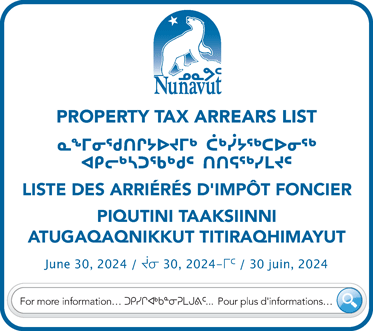City of Iqaluit eyes privately developed subdivision
If council approves plan, it could lead to 40 to 60 new single-family homes in Tundra Valley area
The City of Iqaluit is considering this area between Abe Okpik Crescent and Nanuq Crescent as well as land behind École des Trois-Soleils for a potential subdivision. (Photo by Livete Ataguyuk)
Iqaluit could get 40 to 60 new single-family homes in a city plan to open two plots of land to a privately developed subdivision.
The land between Abe Okpik Crescent and Nanuq Crescent and a plot behind École des Trois-Soleils, also known as the French school, are the areas under consideration.
Mathew Dodds, the city’s director of planning and development, presented details of the plan during Tuesday’s meeting of the Iqaluit planning and development committee.
Those include community engagement on the new subdivision, completion of a land survey sketch of the areas, and amending the city’s general plan and zoning bylaws to allow for the development.

The area in red is the proposed space for a new subdivision between Abe Okpik Crescent and Nanuq Crescent. (Photo courtesy of the City of Iqaluit)
The city would issue a call for proposals for developers to lead the project.
The proposal comes from a planning and development committee meeting last November, where members directed city staff to look into requirements for trucked services in the Abe Okpik Crescent area, as well as a recommendation on the potential for a trucked services subdivision in Tundra Valley East.
Historically, the City of Iqaluit has facilitated construction of roads and lots for new subdivisions through a ballot draw system that designates who gets each lot and is allowed to develop on it, Dodds said.
However, there is a municipal bylaw that allows the city to transfer these lands to a developer who would build roads, trucked-services infrastructure and houses and sell those houses to the public.
The benefit, said Dodds, is this is a streamlined approach to building more family housing in Iqaluit.

The area in red is the proposed space for a new subdivision behind École des Trois-Soleils. (Photo courtesy of the City of Iqaluit)
It comes with risks too, as this approach has never been tested in Iqaluit, he said.
The call for proposals would include stipulations that the developer be an Inuit firm and the housing would be offered first to Inuit.
Dodds said that aligns with Nunavut Tunngavik Inc.’s housing action plan, which calls for housing that is “for Inuit, by Inuit.”
The committee voted to recommend that council approve Dodds’s proposals. Several councillors noted their excitement for the project, including Deputy Mayor Kim Smith and Coun. Kyle Sheppard.
In response to questions about affordability, Dodds said that calculating affordable housing in Iqaluit is difficult because of the amount of government housing in the city.
He said he hopes to come back to council with a figure that likely would be a percentage below market value.
“It’s something we’re still figuring out,” Dodds said.
It’s too early to say when construction on a subdivision might begin, Dodds told Nunatsiaq News.
“We’re taking it step-by-step,” he said.
The plan will now head to council for approval, possibly as early as its next meeting on Feb. 27 according to city spokesperson Aleksey Cameron.






I am not sure what City Counsel is thinking with the suggested location behind the French School. It is all boggy/swampy land, that becomes soaked in the spring time. It is no different that the land that the AWG arena was built on, which our local elders said was not a good place to build any structure, because the building would sink, which it did. This led to multi-millions of dollars being spent to repair it. The road to the addition to the French School and the addition are not even 2 years old. Common sense would be to wait and see how the road and the addition to the school are affected by the land that they are built on before starting any new projects. I would not buy any home that is built there.
In addition, before the City Counsel starts agreeing to building any new homes, it should figure out a dependable water source for the community and share this plan with the community.
What’s swampy? The earth thaws and melts. That’s nature. Iqaluit calls a 15 kmh wind blizzard and cancel schools. In kivalliq that’s not even a blizzard. Windy weather. Blowing snow.
It’s swampy because a small creek runs through there, probably part of the same water system that led to the AWG sinking.
You can see evidence of bad foundation in every nunavut community. In every house, apartment, small or big buildings. You can see cracks in the floor and walls of 99.9% of dwellings in nunavut. It’s caused by thawing of permafrost. It also sinks when the weather cools down. Frozen icy ground. The poles slip into the earth more. Iqaluit needs to stop sitting on a high horse.
While Iqaluit definitely needs more housing, a couple of questions:
1. Regarding affordability; despite the difficulties in calculating it, all they need to do is look at market rates now. There is nothing under $500K, If these don’t sell, will renting at a lower cost be an option? For Inuit and By Inuit is a lovely tagline, but this is never a guarantee.
2. It will be the developer’s role to make sure the buildings are connected to existing water infrastructure. Iqaluit already has an issue with water now and has boil water advisories frequently. Can the city confidently say that this development can be supported by the city’s infrastructure?
Housing is definitely needed, but Iqaluit is expanding at a pace that is far faster than the city can support. Hopefully these can be looked at as part of the approvals process. Council appears excited, but hopefully this will not overwhelm the need for practicality and common sense.
Watch even more “ Inuit companies “ and “Inuit families “ to come out of the woodwork.
Guaranteed
Thanks
Most municipalities develop this way. The municipality set stardards for roads and services through aa development agreement. The developers builds the subdivision. The municipality usually specfies a portion of land set aside for playground or other common element. The municipality is not out of pocket or fronting any funds. When roads and services are approved and tested they are assumed by the municipality with ofsetting tax revenue for operational costs. Could it be possible iqualuit is finally crawling towards common sense.
Many years ago I tried to lease a lot between the crescents to build a house for my family. I was told that wind studies had determined that the land was not practical to build on due to high winds.
Have the winds changed?
Did I have the wrong name?
Will the builder be building underground?
Now it is also time to do away with the foolish lottery system. It is plagued by people playing loopholes who represent first time homeowners to get pole position in the lottery. A anyone who has participated in the lottery knows full well hw it works. The city staff know it and it is one of the worst kept secrets.
This is not the first time this approach has been used.
In 1990 Tom Webster and Jacques Belleau built houses for a subdivision across from Inuksugait Plaza.
Can the current level of city services support 40-60 more units on trucked services? Why can’t the subdivision be connected to city water? Is there enough water for more development?
Where will the kids who live there go to school? The kids living on Joamie Court were supposed to go to Nakasuk because Joamie is at capacity.
Anyone who thinks that a private developer will build “affordable” housing in this market is dreaming in technicolor. Right now the construction cost of a square foot of space is almost $1,000/ft. At those costs a 1,200 square foot house will cost about a million dollars to build. You can bet your bottom dollar that if the developer isn’t guaranteed of selling those units for his construction costs that a: they will never be built or b: they will priced in such a way to ensure that almost all Inuit will be unable to afford them.
The area between Abe Okpik Crescent and Nanuq Crescent has always been designated green space, which is why it requires amending the city’s general plan and zoning bylaws to allow for the development. I understand the need for housing in the city, but I don’t know if the solution is to use up the little bit of set-aside green space within the city. I highly question the use of adding trucked service residences, as I think the city needs to move away from trucked services, not add to it. Although there is some flat land in that area, some of it is on quite a slope, which doesn’t necessarily mean it’s unsuitable for houses, but would be a concern to address. I agree with a previous commenter about the swampiness of the area behind AWG, that should be a major concern. Unfortunately there aren’t many great areas for the city to expand into, but I still see Road to Nowhere and Road to Apex as the best options.
Yes to every word you said! Yes, we need houses, but why does the city wants to put us on top of one another? Not another plateau subdivision please. Road to nowhere and road to apex are a great expansion plan even if it goes on trucked water. However with those 2, it can be tapped into utilidor. And what is this talk about sustainability but here the city is thinking of adding more trucks on the road? more pollution?
NCC proposed private land development way back in 2004. Fell to the wayside! Previous site development approved by past council was the Road to Nowhere, that site tossed aside for another.
When will these words ever become reality I wonder.
iqaluit should use the technology i saw use in alaska on a youtube sink hole documentary, its simple,its the same pole use by canada drill but they use a jack on each of them to slowly lift evenly the house or building as each pole sick independently of each other. as each pole can sink faster or not at all. its ingenious and not costly,its like a heavy machinery truck jack i think? but it works.
https://www.youtube.com/watch?v=HvKpnaXYUPU
its at 42:23